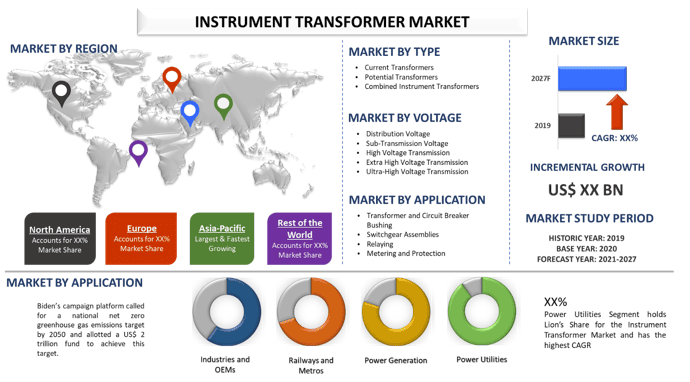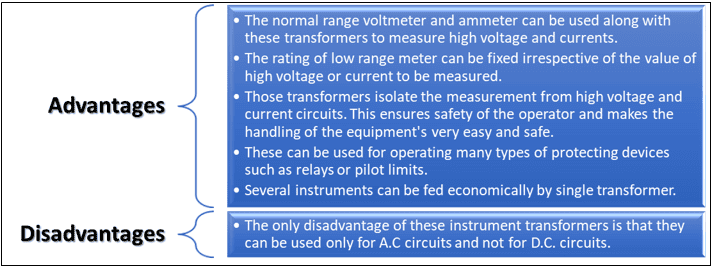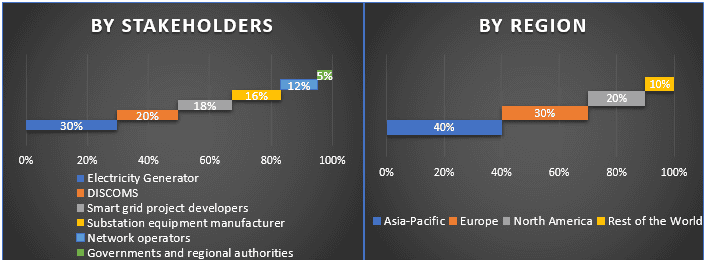- Startseite
- Über uns
- Industrie
- Dienstleistungen
- Lesen
- Kontaktieren Sie uns
Instrumententransformationsmarkt: Aktuelle Analyse und Prognose (2021-2027)
Fokus auf Typ (Stromwandler, Spannungswandler, Kombinierte Messwandler); Spannung (Verteilungsspannung, Untertransmissionsspannung, Hochspannungsübertragung, Höchstspannungsübertragung, Ultrahochspannungsübertragung); Anwendung (Transformator- und Leistungsschalterdurchführung, Schaltanlagen, Relaissteuerung, Messung und Schutz); Endabnehmer (Energieversorgungsunternehmen, Energieerzeugung, Eisenbahnen und Metros, Industrie und OEMs); und Region/Land

Es wird erwartet, dass der Markt für Messwandler im Prognosezeitraum (2021-2027) mit einer beträchtlichen CAGR von ~7 % wachsen wird. Die Messung von elektrischen Größen auf hohem Niveau kann mit einem Gerät, nämlich dem Messwandler, durchgeführt werden. Diese Transformatoren spielen eine wesentliche Rolle in den aktuellen Stromnetzen. Spannungen und Ströme innerhalb eines Stromnetzes sind sehr groß, weshalb eine direkte Messung von Spannung und Betrag mit hoher Größenordnung nicht möglich ist. Aus diesem Grund benötigen wir Messinstrumente für Spannung und Betrag mit hoher Größenordnung, die nicht möglich sind. Wir benötigen also Messinstrumente mit einem hohen Messbereich oder es gibt eine andere Technik, z. B. die Verwendung der Umwandlungseigenschaft innerhalb von Wechselströmen sowie Spannungen. Ein Transformator wird verwendet, um den Strom oder die Spannung nach unten zu transformieren, wenn das Übersetzungsverhältnis bekannt ist, nachdem die heruntertransformierte Größe unter Verwendung eines üblichen Bereichs des Geräts bestimmt wurde. Die eindeutige Größe wird einfach durch Multiplizieren des Ergebnisses mit dem Umwandlungsverhältnis bestimmt. Transformatoren wie diese haben ein präzises Übersetzungsverhältnis als Messwandler.
Messwandler wie CTs oder Stromwandler spielen eine wesentliche Rolle bei der Überwachung und dem Schutz von elektrischen Energiesystemen. Diese Arten von Messwandlern werden hauptsächlich verwendet, um den Strom unter Verwendung von Relais, Messgeräten, Steuergeräten und anderen Instrumenten in einen reduzierten Sekundärstrom zu ändern. Die Prüfung eines Messwandlers ist unerlässlich, wenn es zu Mess-, Verbindungs- und Schutzfehlern kommt, da andernfalls ein hoher Grad an Genauigkeit drastisch reduziert werden kann. Gleichzeitig treten elektrische Veränderungen innerhalb eines Stromwandlers auf. Aus diesen Gründen ist es notwendig, Stromwandler zusammen mit den angeschlossenen Geräten in normalen Abständen zu überprüfen und einzustellen. Es gibt einige elektrische Tests, die für diese Transformatoren eingesetzt werden und die Genauigkeit und optimale Betriebssicherheit gewährleisten, wie z. B. Verhältnis-, Polaritäts-, Erregungs-, Isolations-, Wicklungs- und Bürdentest.
Vor- und Nachteile von Messwandlern
ABB, General Electric, Siemens, Schneider Electric, CG Power and Industrial Solutions Limited, Eaton Corporation, Toshiba Corporation, Bharat Heavy Electricals Limited, Mitsubishi Electric Corporation und Raychem RPG Private Limited sind einige der bekanntesten Akteure auf dem Markt für Messwandler. Mehrere Fusionen und Übernahmen sowie Partnerschaften wurden von diesen Akteuren unternommen, um Kunden mit Hightech- und innovativen Produkten/Technologien zu unterstützen.
Im Bericht dargestellte Erkenntnisse
"Unter den Typen hält das Segment der Stromwandler den größten Anteil"
Basierend auf dem Typ ist der Markt für Messwandler in Stromwandler, Spannungswandler und kombinierte Messwandler unterteilt. Stromwandler sind Geräte, die Ströme über 5 A messen können. Die Stromstärke der Primärwicklung eines Stromwandlers wird durch den Maximalwert des zu messenden Laststroms bestimmt. Wenn beispielsweise die Stromstärke 400 A bei einer Sekundärstromstärke von 5 A beträgt, beträgt das Verhältnis zwischen Primär- und Sekundärstromstärke 400:5 oder 80:1.
"Unter den Spannungen hält das Segment der Hochspannungsübertragung den größten Anteil"
Basierend auf dem Typ ist der Markt für Messwandler in Verteilungsspannung, Unterübertragungsspannung, Hochspannungsübertragung, Höchstspannungsübertragung und Ultrahochspannungsübertragung unterteilt. Die Hochspannungs-Gleichstrom-Übertragung (HVDC) verwendet Gleichstrom (DC) für die Übertragung von elektrischer Energie im Gegensatz zu den häufigeren Wechselstromsystemen (AC). Die meisten HVDC verwenden typischerweise Spannungen zwischen 100 kV und 800 kV. Eine 1.100-kV-Verbindung in China wurde jedoch 2019 über eine Entfernung von 3.300 km mit einer Leistungskapazität von 12 GW fertiggestellt.
"Unter den Anwendungen hält das Segment Messung und Schutz den größten Anteil"
Basierend auf der Anwendung ist der Markt für Messwandler in Transformator- und Leistungsschalterdurchführungen, Schaltanlagen, Relais und Messung und Schutz unterteilt. Mess-CTs funktionieren ähnlich wie tragbare Zangenamperemeter, nur dass sie in der Regel einen größeren Bereich haben. Sie können den Stromfluss überwachen und Ihnen den aktuellen Verbrauch anzeigen. Mess-CTs funktionieren ähnlich wie tragbare Zangenamperemeter, nur dass sie in der Regel einen größeren Bereich haben.
"Unter den Endnutzern hält das Segment Energieversorgungsunternehmen den größten Anteil"
Basierend auf der Anwendung ist der Markt für Messwandler in Energieversorgungsunternehmen, Energieerzeugung, Eisenbahnen und Metros sowie Industrien und OEMs unterteilt. Unter den Anwendungen dominierte das Segment Energieversorgungsunternehmen den Markt im Jahr 2020. Die US-amerikanische Energieversorgungsindustrie führte den Übergang zu sauberer Energie im Jahr 2020 trotz des Gegenwinds der Bundespolitik an. Der Druck von Interessengruppen, von Bürgern bis hin zu Aktionären, verstärkte sich im vergangenen Jahr, das sich eng an die Empfehlungen des Pariser Klimaabkommens anlehnte.
"Der asiatisch-pazifische Raum stellt einen der größten Märkte für Messwandler dar"
Für ein besseres Verständnis der Marktdynamik des Marktes für Messwandler wurde eine detaillierte Analyse für verschiedene Regionen in Indien durchgeführt, darunter Nordamerika (USA, Kanada, Rest von Nordamerika), Europa (Deutschland, Großbritannien, Frankreich, Spanien, Italien, Rest von Europa), Asien-Pazifik (China, Japan, Indien, Australien, Rest von Asien-Pazifik), Rest der Welt. Der asiatisch-pazifische Raum dominierte den Markt im Jahr 2020.
Gründe für den Kauf dieses Berichts:
- Die Studie umfasst eine Marktdimensionierungs- und Prognoseanalyse, die von authentifizierten wichtigen Branchenexperten validiert wurde
- Der Bericht bietet einen schnellen Überblick über die Gesamtleistung der Branche auf einen Blick
- Der Bericht enthält eine eingehende Analyse der wichtigsten Branchenvertreter mit einem primären Fokus auf wichtige Finanzkennzahlen, Produktportfolio, Expansionsstrategien und aktuelle Entwicklungen
- Detaillierte Untersuchung von Treibern, Hemmnissen, wichtigen Trends und Chancen, die in der Branche vorherrschen
- Die Studie deckt den Markt umfassend über verschiedene Segmente hinweg ab
- Tiefgehende regionale Analyse der Branche
Anpassungsoptionen:
Der Markt für Messwandler kann weiter an die Anforderungen oder jedes andere Marktsegment angepasst werden. Darüber hinaus versteht UMI, dass Sie möglicherweise Ihre eigenen geschäftlichen Anforderungen haben. Zögern Sie daher nicht, sich mit uns in Verbindung zu setzen, um einen Bericht zu erhalten, der Ihren Anforderungen vollständig entspricht.
Inhaltsverzeichnis
Die Analyse des historischen Marktes, die Schätzung des aktuellen Marktes und die Prognose des zukünftigen Marktes für den Messwandlermarkt waren die drei wichtigsten Schritte, die unternommen wurden, um die Akzeptanz von Messwandlern in wichtigen Regionen weltweit zu schaffen und zu analysieren. Es wurde eine umfassende Sekundärforschung durchgeführt, um die historischen Marktzahlen zu sammeln und die aktuelle Marktgröße zu schätzen. Zweitens wurden zahlreiche Erkenntnisse und Annahmen berücksichtigt, um diese Erkenntnisse zu validieren. Darüber hinaus wurden umfassende Primärinterviews mit Branchenexperten entlang der Wertschöpfungskette des Messwandlermarktes geführt. Nach der Annahme und Validierung der Marktzahlen durch Primärinterviews haben wir einen Top-Down-/Bottom-Up-Ansatz verwendet, um die vollständige Marktgröße zu prognostizieren. Anschließend wurden Methoden zur Marktaufschlüsselung und Datentriangulation angewendet, um die Marktgröße von Segmenten und Untersegmenten, die die Branche betreffen, zu schätzen und zu analysieren. Die detaillierte Methodik wird im Folgenden erläutert:
Analyse der historischen Marktgröße
Schritt 1: Eingehende Untersuchung sekundärer Quellen:
Es wurde eine detaillierte Sekundärstudie durchgeführt, um die historische Marktgröße des Messwandlers aus unternehmensinternen Quellen wie Geschäftsberichten & Finanzberichten, Performance-Präsentationen, Pressemitteilungen usw. und externen Quellen wie Fachzeitschriften, Nachrichten & Artikeln, Regierungsveröffentlichungen, Wettbewerberpublikationen, Sektorberichten, Datenbanken von Drittanbietern und anderen glaubwürdigen Veröffentlichungen zu erhalten.
Schritt 2: Marktsegmentierung:
Nachdem wir die historische Marktgröße des Messwandlermarktes erhalten hatten, führten wir eine detaillierte Sekundäranalyse durch, um historische Markteinblicke und Anteile für verschiedene Segmente & Untersegmente für wichtige Regionen zu sammeln. Die wichtigsten im Bericht enthaltenen Segmente sind Typ, Spannung, Anwendung und Endverbraucher. Darüber hinaus wurden Länderanalysen durchgeführt, um die allgemeine Akzeptanz von Messwandlern in dieser Region zu bewerten.
Schritt 3: Faktorenanalyse:
Nachdem wir die historische Marktgröße verschiedener Segmente und Untersegmente ermittelt hatten, führten wir eine detaillierte Faktorenanalyse durch, um die aktuelle Marktgröße von Messwandlern zu schätzen. Darüber hinaus führten wir eine Faktorenanalyse unter Verwendung abhängiger und unabhängiger Variablen wie zunehmende Urbanisierung und Stromerzeugung durch. Es wurde eine gründliche Analyse der Angebots- und Nachfrageszenarien unter Berücksichtigung von Top-Partnerschaften, Fusionen und Übernahmen, Geschäftsausweitungen und Produkteinführungen im Messwandlersektor auf der ganzen Welt durchgeführt.
Aktuelle Marktzößeätzung & Prognose
Aktuelle Marktgrößenbestimmung: Basierend auf den umsetzbaren Erkenntnissen aus den obigen 3 Schritten haben wir die aktuelle Marktgröße, die wichtigsten Akteure im Messwandlermarkt und die Marktanteile der Segmente ermittelt. Alle erforderlichen prozentualen Anteile und Marktaufschlüsselungen wurden unter Verwendung des oben genannten sekundären Ansatzes ermittelt und durch Primärinterviews überprüft.
Schätzung & Prognose: Für die Marktschätzung und -prognose wurden verschiedene Faktoren gewichtet, darunter Treiber & Trends, Einschränkungen und Chancen für die Stakeholder. Nach der Analyse dieser Faktoren wurden relevante Prognosetechniken, d. h. ein Top-Down-/Bottom-Up-Ansatz, angewendet, um die Marktprognose bis etwa 2027 für verschiedene Segmente und Untersegmente in den wichtigsten Märkten weltweit zu erhalten. Die Forschungsmethodik zur Schätzung der Marktgröße umfasst:
- Die Marktgröße der Branche in Bezug auf Wert (US$) und die Akzeptanzrate von Messwandlern in den wichtigsten Märkten im Inland
- Alle prozentualen Anteile, Aufteilungen und Aufschlüsselungen von Marktsegmenten und -untersegmenten
- Wichtige Akteure im Messwandlermarkt in Bezug auf die angebotenen Produkte. Außerdem die Wachstumsstrategien, die von diesen Akteuren angewendet werden, um im schnell wachsenden Markt zu konkurrieren
Validierung der Marktgröße und des Marktanteils
Primärforschung: Es wurden ausführliche Interviews mit den wichtigsten Meinungsbildnern (Key Opinion Leaders, KOLs) geführt, darunter Führungskräfte der obersten Ebene (CXO/VPs, Vertriebsleiter, Marketingleiter, Betriebsleiter und Regionalleiter, Länderleiter usw.) in wichtigen Regionen. Die Ergebnisse der Primärforschung wurden dann zusammengefasst und eine statistische Analyse durchgeführt, um die aufgestellte Hypothese zu beweisen. Die Erkenntnisse aus der Primärforschung wurden mit den sekundären Erkenntnissen zusammengeführt, wodurch Informationen in umsetzbare Erkenntnisse umgewandelt wurden.
Aufteilung der primären Teilnehmer in verschiedene Regionen
Markt Engineering
Die Datentriangulationstechnik wurde angewendet, um die Gesamtmarktschätzung abzuschließen und präzise statistische Zahlen für jedes Segment und Untersegment des Messwandlermarktes zu erhalten. Die Daten wurden in mehrere Segmente & Untersegmente aufgeteilt, nachdem verschiedene Parameter und Trends in den Bereichen Typ und deren Typ des Messwandlermarktes untersucht wurden.
Das Hauptziel der Instrument Transformer Market Study
Die aktuellen & zukünftigen Markttrends von Messwandlern wurden in der Studie genau bestimmt. Investoren können strategische Einblicke gewinnen, um ihre Entscheidungen für Investitionen auf der Grundlage der in der Studie durchgeführten qualitativen und quantitativen Analyse zu treffen. Aktuelle und zukünftige Markttrends bestimmten die Gesamtattraktivität des Marktes auf regionaler Ebene und boten dem Industrieteilnehmer eine Plattform, um den unerschlossenen Markt zu nutzen und von einem First-Mover-Vorteil zu profitieren. Weitere quantitative Ziele der Studien sind:
- Analysieren Sie die aktuelle und prognostizierte Marktgröße von Messwandlern in Bezug auf den Wert (US$). Analysieren Sie auch die aktuelle und prognostizierte Marktgröße verschiedener Segmente und Untersegmente
- Die Segmente in der Studie umfassen die Bereiche Typ, Spannung, Anwendung und Endverbraucher
- Definieren und analysieren Sie den regulatorischen Rahmen für die Messwandlerindustrie
- Analysieren Sie die Wertschöpfungskette unter Einbeziehung verschiedener Vermittler sowie die Analyse des Kunden- und Wettbewerbsverhaltens der Branche
- Analysieren Sie die aktuelle und prognostizierte Marktgröße des Messwandlermarktes für die Hauptregion
- Zu den in dem Bericht untersuchten Hauptregionen gehören Nordamerika (USA, Kanada, Rest Nordamerikas), Europa (Deutschland, Großbritannien, Frankreich, Spanien, Italien, Rest Europas), Asien-Pazifik (China, Japan, Indien, Australien, Rest Asien-Pazifik), Rest der Welt.
- Unternehmensprofile des Messwandlermarktes und die Wachstumsstrategien, die von den Marktteilnehmern angewendet werden, um sich in dem schnell wachsenden Markt zu behaupten
Detaillierte regionale Analyse der Branche
Verwandt Berichte
Kunden, die diesen Artikel gekauft haben, kauften auch










